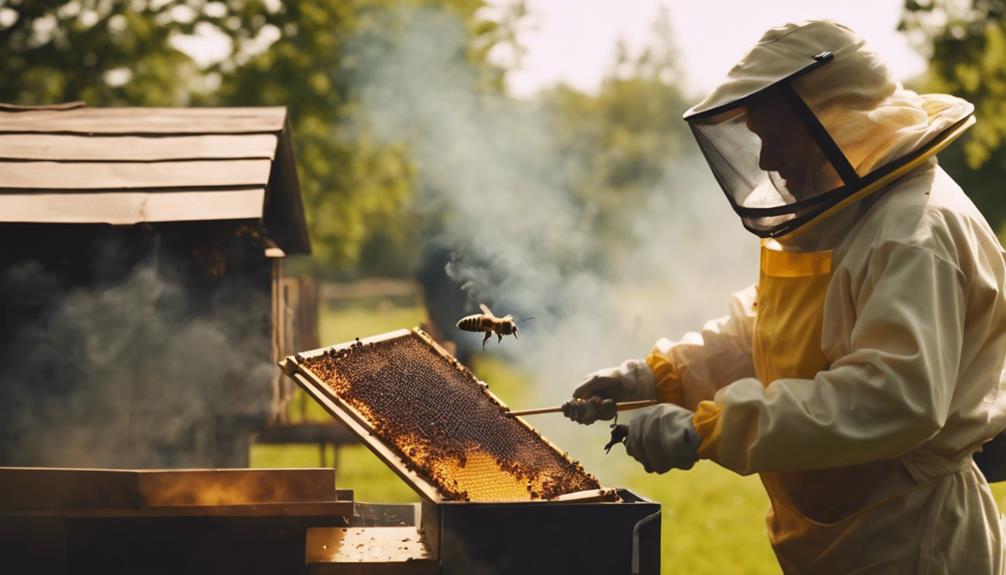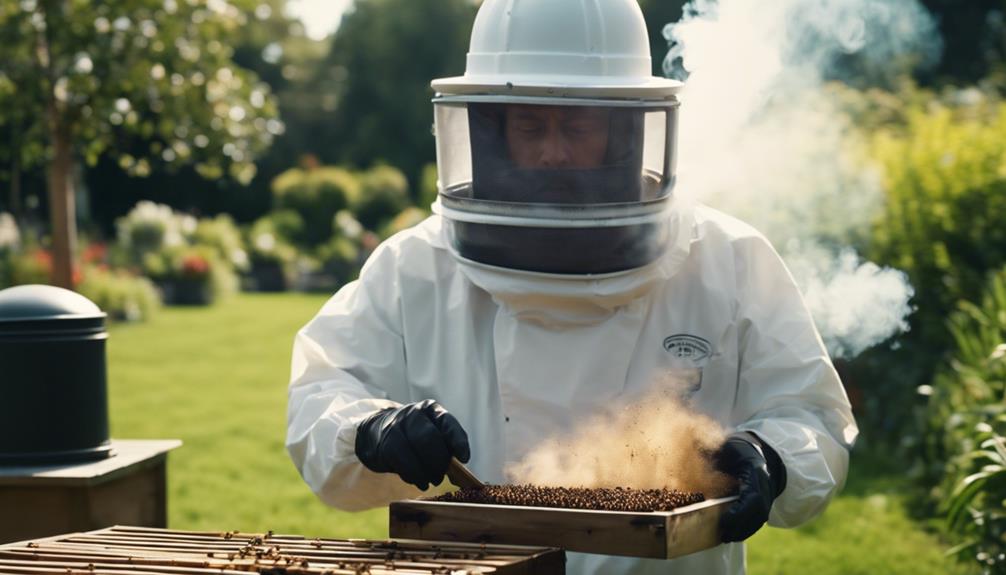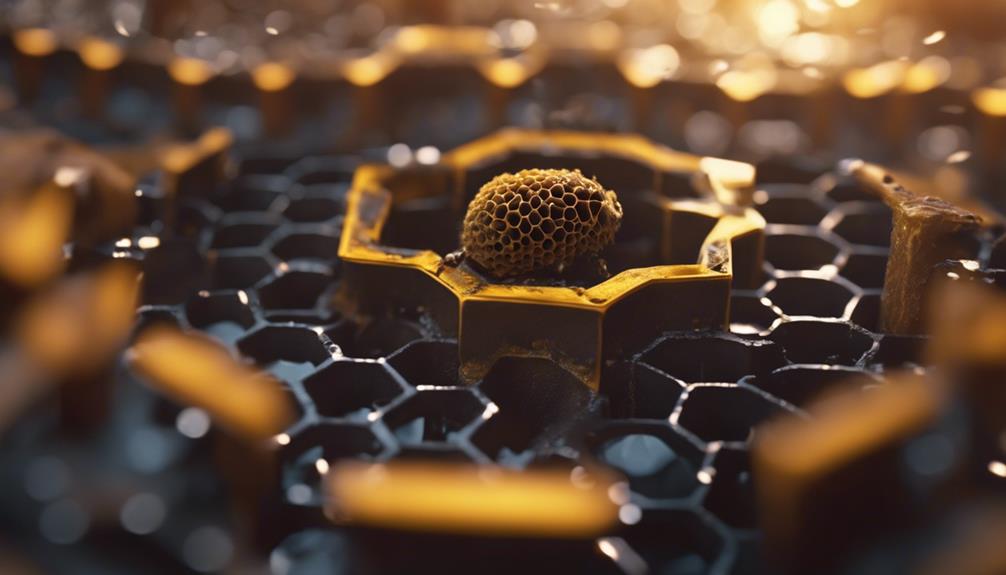Exploring the world of beekeeping harmony and using a smoker is crucial for calming bees safely. We conceal their alarm pheromones with smoke, so they remain relaxed during hive inspections. It’s like treating them to a spa day to unwind while also ensuring our safety. The smoke prompts bees to concentrate on feeding, not stinging, making our work seamless and stress-free. Keep in mind, a gentle touch and the appropriate smoke level are the key elements to a happy hive. Delve deeper into the realm of beekeeping harmony and uncover more ways to keep our buzzing buddies serene.
Main Points
- Bee smokers mask alarm pheromones, keeping bees calm and preventing aggressive behavior.
- Smoke signals bees to feed, not sting, promoting a safe environment for beekeepers.
- Proper smoke application ensures bees’ focus on honey, enhancing safety during hive inspections.
- Using cool smoke judiciously helps calm bee behavior and allows efficient beekeeping work.
- Observing bee response and adjusting smoke levels prevent over-smoking, maintaining a gentle approach.
Benefits of Using a Bee Smoker
Using a bee smoker provides beekeepers with essential benefits for safely managing bee colonies. Bee smokers play an important role in keeping bees calm by masking their alarm pheromones with smoke. This clever technique helps prevent aggressive behavior during hive inspections, creating a safer environment for both the bees and the beekeeper.
When bees encounter the smoke, they interpret it as a signal to start feeding rather than stinging, making interactions much more pleasant. By utilizing a bee smoker properly, beekeepers can work with their colonies more efficiently and without causing undue stress to the bees.
It’s truly remarkable how a simple tool like a bee smoker can make such a significant difference in beekeeping practices.
Types of Suitable Smoker Fuels
In order to maintain our bees’ calm, we need to be mindful of the fuels we use in our smokers.
Bee-friendly fuels like burlap and pine needles can assist us in achieving effective smoke for our hive inspections.
Bee-Friendly Smoker Fuels
Choosing natural, untreated materials like burlap, wood pellets, pine needles, and dried herbs as smoker fuels is important for maintaining a safe and calm environment for bees during hive inspections. These bee-friendly options help promote bee health by ensuring that harmful substances like bleach, dyes, glues, pesticides, plastic, or dryer lint aren’t introduced into the hive environment.
Effective Smoker Fuel
To maintain a peaceful and safe environment for bees during hive inspections, opting for suitable smoker fuels like burlap, wood pellets, pine needles, dried herbs, and cardboard is essential. When selecting smoker fuel, it’s important to make sure it’s free of bleach, dyes, glues, pesticides, plastic, or dryer lint. Keeping the smoker clean from resin buildup is also vital to prevent airflow obstructions.
By choosing clean and natural fuels, beekeepers can effectively calm bees without compromising their health. Remember, the right fuel not only aids in hive inspections but also contributes to the overall well-being of the bees. Let’s delve deeper into the world of smoker fuels to create a harmonious beekeeping experience.
- Burlap
- Wood pellets
- Pine needles
Importance of Masking Bee Pheromones
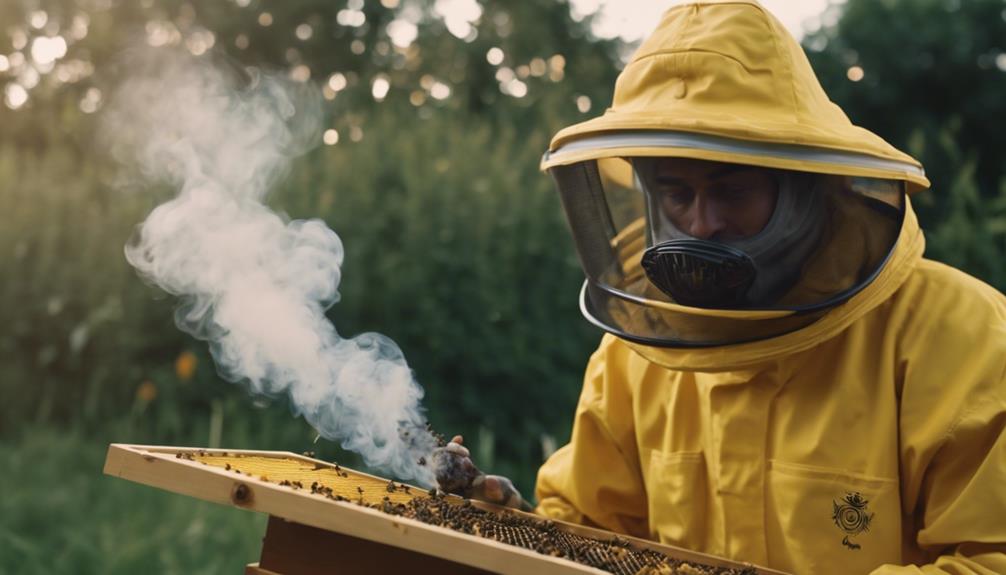
When beekeeping, it’s important to understand the significance of masking bee pheromones with smoke. This technique helps us stay safe while handling hives and keeps the bees calm during inspections.
Masking Bee Scent
Masking bee scent with smoke plays an important role in calming bees during hive inspections and manipulations. The smoke from a bee smoker disrupts bees’ alarm pheromones, preventing them from signaling danger and reducing aggression. Here are three key reasons why masking bee scent is vital:
- Prevents alarm response: Smoke interferes with bees’ ability to communicate through pheromones, keeping them from becoming defensive.
- Promotes focus on honey: By disrupting their sense of smell, smoke encourages bees to concentrate on consuming honey rather than stinging.
- Enhances safety: Calming bees with smoke is a safe and effective method for beekeepers to work with hives without triggering defensive responses.
Safety When Handling
By masking bee pheromones, beekeepers guarantee a safer environment for handling hives and minimize the risk of provoking defensive behavior in bees. When using a smoker, the controlled release of smoke helps calm bees by concealing their alarm pheromones, ensuring a more relaxed hive atmosphere. This technique disrupts the bees’ communication signals, preventing them from signaling danger to the rest of the colony.
As a result, beekeepers can conduct inspections and maintenance without triggering defensive responses in the bees. The safe environment created by the controlled use of smoke not only benefits the beekeepers but also safeguards the well-being of the bees. Remember, proper handling techniques and the judicious use of a smoker are essential for a harmonious interaction with our buzzing friends.
Calming Bee Behavior
Ensuring a peaceful hive environment is essential for beekeepers to safely handle their hives and minimize defensive reactions from bees. In terms of calming bee behavior, using smoke plays a pivotal role in maintaining harmony within the hive.
Here’s why smoke is an indispensable tool for beekeepers:
- Smoke masks bees’ alarm pheromones, preventing them from detecting danger signals.
- Calming bees with smoke helps beekeepers work in hives without triggering defensive responses.
- The use of smoke disrupts bees’ communication, reducing their ability to coordinate defensive actions.
Guidelines for Judicious Smoker Use
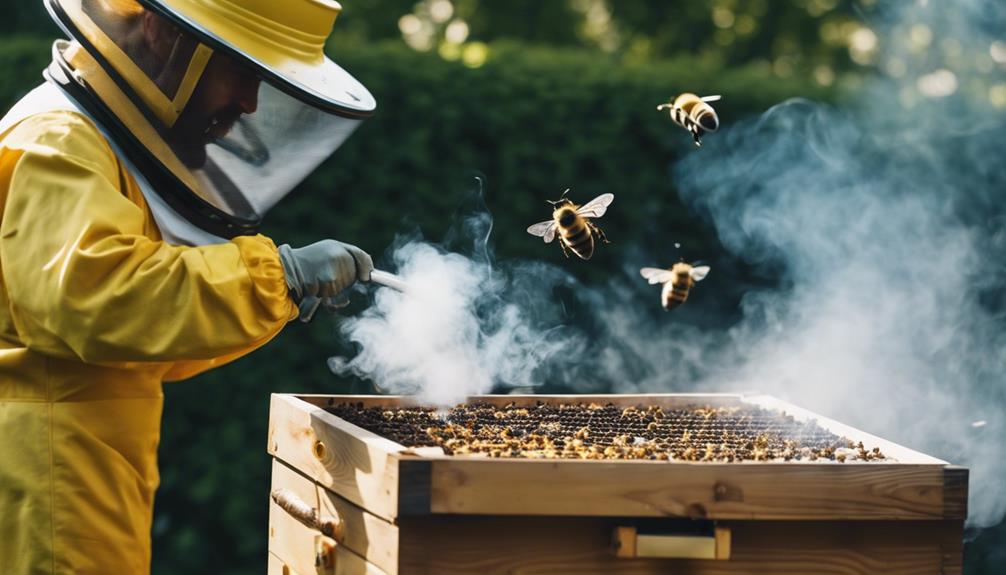
To effectively calm bees during hive inspections, it’s imperative to use cool smoke and apply it carefully at the hive entrance to prevent aggressive behavior. Cool smoke not only keeps the bees safe but also helps mask their alarm pheromones, allowing you to work without triggering defensive responses.
Remember, proper airflow in the smoker is key to maintaining a consistent smoke supply without overheating. Using smoke in moderation is vital; too much can drive bees out unnecessarily. After smoking, give the bees a moment to settle and consume honey, creating a more tranquil environment for your beekeeping tasks.
Maintenance Tips for Bee Smoker
How often should beekeepers clean their smokers to maintain peak performance and safety? Regular cleaning is key to keeping your bee smoker in top shape. To guarantee your smoker serves you well, here are some maintenance tips to follow:
- Clean the smoker regularly: Removing resin buildup is essential for proper airflow.
- Use suitable fuels: Opt for burlap, wood pellets, or pine needles to maintain effective smoke production.
- Inspect components: Check the bellow, nozzle, and fire chamber for any damage or wear.
Ensuring Safe Extinguishing Practices
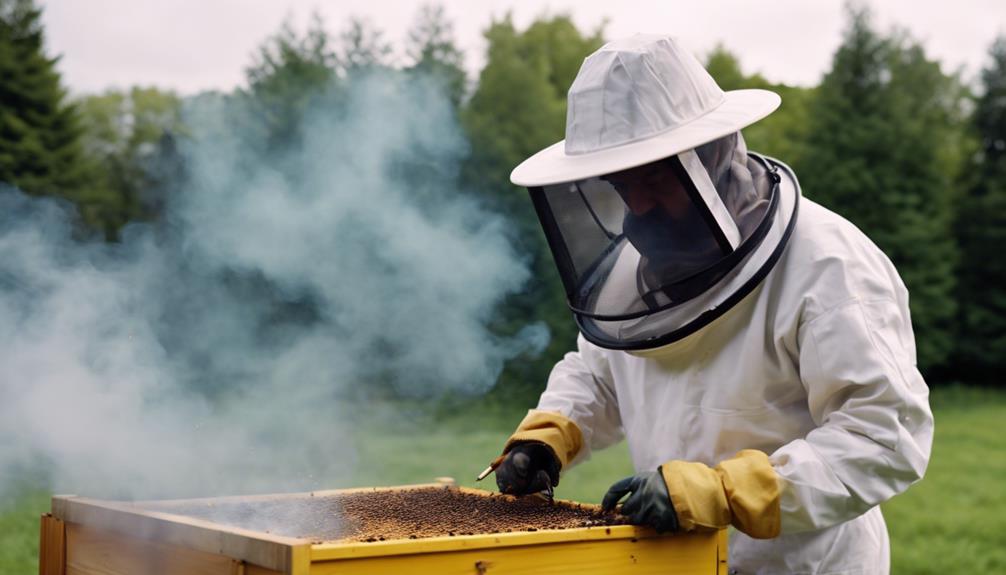
When maintaining a bee smoker, ensuring proper extinguishing practices is essential for safety and preventing fire hazards.
To extinguish a smoker, block the air intake with grass or a cork to stop smoke production safely. Remember, never place a still-burning smoker in a vehicle to avoid fire risks and potential accidents. Dispose of smoker embers carefully to prevent unintended fires and ensure everyone’s safety.
Also, when collecting comb honey, refrain from smoking bees to avoid imparting a smoky flavor to the honey. It’s best to skip smoking bees during droughts and for beekeepers allergic to smoke to maintain safety and bee health.
Preventing Over-Smoking in Beekeeping
Excessive smoke in beekeeping practices can disrupt the hive and cause unnecessary stress to the bees. Finding the right balance is key to ensuring a smooth beekeeping experience.
Here are some tips to prevent over-smoking:
- Observe Bee Behavior: Pay attention to how the bees react to the smoke. If they start to become agitated or try to escape the hive, it’s a sign you may be using too much.
- Adjust Smoke Levels: Be ready to adjust the amount of smoke based on the bees’ response. Less is often more effective in keeping the bees calm without overwhelming them.
- Maintain a Balanced Approach: Aim for a gentle application of smoke to achieve the desired calming effect without causing unnecessary disturbance.

Roger Thomas is a seasoned beekeeper and hive architect with a deep-seated passion for sustainable living. His fascination with bees has shaped his professional career, giving him practical and theoretical expertise in bee behavior, colony health, and optimal hive conditions. Roger’s technical skills shine in his bespoke hive creations that cater to the specific needs of diverse bee species, while his sustainable practices promote environmental balance and the wellbeing of the bee population.
As he continues his journey in beekeeping, Roger has become a dedicated advocate for responsible practices and an insightful educator in his field. His posts aim to inspire new beekeepers, underline the importance of sustainability, and showcase the remarkable contribution bees make to our ecosystem. Roger invites you to join him as he delves into the world of bees and the rewarding, honey-sweet art of beekeeping.
